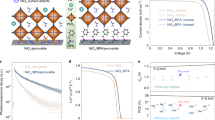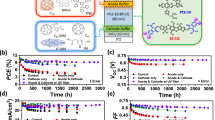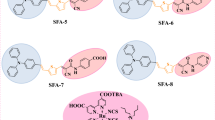Abstract
Inverted organic solar cells are attractive for commercialization. However, their power conversion efficiency (PCE) still lags their conventional architecture counterpart. Here we propose a new approach to enhance the performance and stability of structure-inverted non-fullerene organic solar cells. We use an in situ-derived inorganic SiOxNy passivation layer, formed by curing a solution-deposited perhydropolysilazane thin film in ambient atmosphere on top of the commonly used ZnO transport layer. Oxygen vacancies and dangling bonds of ZnO create a doped region in the photoactive layer, leading to losses in photocurrent due to enhanced recombination of photogenerated holes within this region. The optimized SiOxNy interlayer effectively passivates the ZnO surface defects by forming Zn–O–Si bonds, leading to a vanishing doped region. At the same time, SiOxNy induces a preferential accumulation of the non-fullerene acceptor near the electron contact, which also favours charge extraction. The combination of both effects leads to increased photocurrent density and PCE, with certified PCE values of 18.49% and 18.06% for cells with active areas of 5.77 mm2 and 100.17 mm2, respectively, using PM6:L8-BO as the photoactive layer. Importantly, cells containing inorganic SiOxNy exhibit an estimated T80 lifetime of 24,700 h (where T80 is the time it takes for the PCE to drop to 80% of its initial value) under white light illumination, corresponding to an operational lifespan exceeding 16 years. The results underscore the potential of our approach for practical applications of highly efficient and stable inverted organic solar cells.
This is a preview of subscription content, access via your institution
Access options
Access Nature and 54 other Nature Portfolio journals
Get Nature+, our best-value online-access subscription
$32.99 / 30 days
cancel any time
Subscribe to this journal
Receive 12 print issues and online access
$259.00 per year
only $21.58 per issue
Buy this article
- Purchase on SpringerLink
- Instant access to full article PDF
Prices may be subject to local taxes which are calculated during checkout




Similar content being viewed by others
Data availability
All data needed to evaluate the conclusions in this paper are present in the Article and its Supplementary Information. Source data are provided with this paper.
References
Cheng, Y.-B., Pascoe, A., Huang, F. & Peng, Y. Print flexible solar cells. Nature 539, 488–489 (2016).
Service, R. F. Solar energy gets flexible. Science 378, 588–591 (2022).
Kaltenbrunner, M. et al. Ultrathin and lightweight organic solar cells with high flexibility. Nat. Commun. 3, 770 (2012).
Zhang, K. et al. Toward solution-processed high-performance polymer solar cells: from material design to device engineering. Chem. Mater. 29, 141–148 (2017).
Meng, L. et al. Organic and solution-processed tandem solar cells with 17.3% efficiency. Science 361, 1094–1098 (2018).
Jiang, Y. et al. An alcohol-dispersed conducting polymer complex for fully printable organic solar cells with improved stability. Nat. Energy 7, 352–359 (2022).
Zhao, W. et al. Molecular optimization enables over 13% efficiency in organic solar cells. J. Am. Chem. Soc. 139, 7148–7151 (2017).
Fu, H., Wang, Z. & Sun, Y. Polymer donors for high‐performance non‐fullerene organic solar cells. Angew. Chem. Int. Ed. 58, 4442–4453 (2019).
Hou, J., Inganäs, O., Friend, R. H. & Gao, F. Organic solar cells based on non-fullerene acceptors. Nat. Mater. 17, 119–128 (2018).
Yuan, J. et al. Single-iunction organic solar cell with over 15% efficiency using fused-ring acceptor with electron-deficient core. Joule 3, 1140–1151 (2019).
Liang, Y. et al. Organic solar cells using oligomer acceptors for improved stability and efficiency. Nat. Energy 7, 1180–1190 (2022).
Yao, Z. et al. Complete peripheral fluorination of the small-molecule acceptor in organic solar cells yields efficiency over 19%. Angew. Chem. Int. Ed. 62, e202312630 (2023).
Cheng, P., Li, G., Zhan, X. & Yang, Y. Next-generation organic photovoltaics based on non-fullerene acceptors. Nat. Photon. 12, 131–142 (2018).
Li, C. et al. Non-fullerene acceptors with branched side chains and improved molecular packing to exceed 18% efficiency in organic solar cells. Nat. Energy 6, 605–613 (2021).
Sun, Y. et al. π-Extended nonfullerene acceptor for compressed molecular packing in organic solar cells to achieve over 20% efficiency. J. Am. Chem. Soc. 146, 12011–12019 (2024).
Guan, S. et al. Self-assembled interlayer enables high-performance organic photovoltaics with power conversion efficiency exceeding 20%. Adv. Mater. 36, 2400342 (2024).
Chen, Z. et al. 20.2% efficiency organic photovoltaics employing a π-extension quinoxaline-based acceptor with ordered arrangement. Adv. Mater. 36, 2406690 (2024).
Jiang, Y. et al. Non-fullerene acceptor with asymmetric structure and phenyl-substituted alkyl side chain for 20.2% efficiency organic solar cells. Nat. Energy 9, 975–986 (2024).
Suo, Z. et al. An efficient interface modification material for improved efficiency and stability in inverted organic solar cells. Mater. Chem. Front. 8, 562–566 (2024).
Xin, Y. et al. Multiarmed aromatic ammonium salts boost the efficiency and stability of inverted organic solar cells. J. Am. Chem. Soc. 146, 3363–3372 (2024).
Duan, L. & Uddin, A. Progress in stability of organic solar cells. Adv. Sci. 7, 1903259 (2020).
Li, S. et al. Achieving over 18% efficiency organic solar cell enabled by a ZnO-based hybrid electron transport layer with an operational lifetime up to 5 years. Angew. Chem. Int. Ed. 61, e202207397 (2022).
Feldmann, F., Bivour, M., Reichel, C., Hermle, M. & Glunz, S. W. Passivated rear contacts for high-efficiency n-type Si solar cells providing high interface passivation quality and excellent transport characteristics. Sol. Energy Mater. Sol. Cells 120, 270–274 (2014).
Huang, J., Yin, Z. & Zheng, Q. Applications of ZnO in organic and hybrid solar cells. Energy Environ. Sci. 4, 3861–3877 (2011).
Vasilopoulou, M. et al. Atomic‐layer‐deposited aluminum and zirconium oxides for surface passivation of TiO2 in high‐efficiency organic photovoltaics. Adv. Energy Mater. 4, 1400214 (2014).
Jiang, Y. Y. et al. Photocatalytic effect of ZnO on the stability of nonfullerene acceptors and its mitigation by SnO2 for nonfullerene organic solar cells. Mater. Horiz. 6, 1438–1443 (2019).
Yu, R. et al. Efficient interface modification via multi-site coordination for improved efficiency and stability in organic solar cells. Energy Environ. Sci. 15, 822–829 (2022).
Wang, Y. et al. New method for preparing ZnO layer for efficient and stable organic solar cells. Adv. Mater. 35, 2208305 (2023).
Bandopadhyay, K. & Mitra, J. Zn interstitials and O vacancies responsible for n-type ZnO: what do the emission spectra reveal? RSC Adv. 5, 23540–23547 (2015).
Li, Y. et al. Non-fullerene acceptor organic photovoltaics with intrinsic operational lifetimes over 30 years. Nat. Commun. 12, 5419 (2021).
Han, Y. et al. An efficiency of 16.46% and a T80 lifetime of over 4,000 h for the PM6:Y6 inverted organic solar cells enabled by surface acid treatment of the zinc oxide electron transporting layer. ACS Appl. Mater. Interfaces 13, 17869–17881 (2021).
Liu, B.-W. et al. ZnO surface passivation with glucose enables simultaneously improving efficiency and stability of inverted polymer:non-fullerene solar cells. Chinese J. Polym. Sci. 40, 1594–1603 (2022).
Zhao, Y. et al. Achieving sustainability of greenhouses by integrating stable semi-transparent organic photovoltaics. Nat. Sustain. 6, 539–548 (2023).
Liu, B. et al. Simultaneously achieving highly efficient and stable polymer:non-fullerene solar cells enabled by molecular structure optimization and surface passivation. Adv. Sci. 9, 2104588 (2022).
Polydorou, E. et al. Improved stability of polymer solar cells in ambient air via atomic layer deposition of ultrathin dielectric layers. Adv. Mater. Interfaces 4, 1700231 (2017).
Tan, J. et al. A ZnO&GeSe composite electron transport layer for organic solar cells. J. Mater. Chem. A 12, 1530–1542 (2024).
Zhang, Z. et al. Hydrophobic, transparent and hard silicon oxynitride coating from perhydropolysilazane. Polym. Int. 64, 971–978 (2015).
Coppa, B., Davis, R. & Nemanich, R. Gold Schottky contacts on oxygen plasma-treated, n-type ZnO (0001). Appl. Phys. Lett. 82, 400–402 (2003).
Sun, Y., Seo, J. H., Takacs, C. J., Seifter, J. & Heeger, A. J. Inverted polymer solar cells integrated with a low‐temperature‐annealed sol‐gel‐derived ZnO film as an electron transport layer. Adv. Mater. 23, 1679–1683 (2011).
Liu, Y. et al. Effects of amorphous-zinc-silicate-catalyzed ozonation on the degradation of p-chloronitrobenzene in drinking water. Appl. Catal. A Gen. 403, 112–118 (2011).
JangJian, S.-K. & Wang, Y.-L. Bonding configuration and electrical properties of nitrogen and fluorine incorporated SiOC:H thin film prepared by plasma enhanced chemical vapor deposition. Surf. Coat. Tech. 200, 3140–3144 (2006).
Roy, A. et al. First preparation of nanocrystalline zinc silicate by chemical vapor synthesis using an organometallic single-source precursor. Chem. Eur. J. 10, 1565–1575 (2004).
Polydorou, E. et al. Insights into the passivation effect of atomic layer deposited hafnium oxide for efficiency and stability enhancement in organic solar cells. J. Mater. Chem. C 6, 8051–8059 (2018).
Hu, Q. et al. Improving efficiency and stability of perovskite solar cells enabled by a near-infrared-absorbing moisture barrier. Joule 4, 1575–1593 (2020).
Sen, S. S. & Roesky, H. W. Silicon-fluorine chemistry: from the preparation of SiF2 to C–F bond activation using silylenes and its heavier congeners. Chem. Commun. 54, 5046–5057 (2018).
Doumon, N. Y. et al. Energy level modulation of ITIC derivatives: effects on the photodegradation of conventional and inverted organic solar cells. Org. Electron. 69, 255–262 (2019).
Gu, H. et al. Revealing the interfacial photoreduction of MoO3 with P3HT from the molecular weight-dependent ‘burn-in’ degradation of P3HT:PC61BM solar cells. ACS Appl. Energ. Mater. 3, 9714–9723 (2020).
Janotti, A. & Van de Walle, C. G. Fundamentals of zinc oxide as a semiconductor. Rep. Prog. Phys. 72, 126501 (2009).
Wilken, S., Parisi, J. R. & Borchert, H. Role of oxygen adsorption in nanocrystalline ZnO interfacial layers for polymer–fullerene bulk heterojunction solar cells. J. Phys. Chem. C 118, 19672–19682 (2014).
Nyman, M. et al. Requirements for making thick junctions of organic solar cells based on nonfullerene acceptors. Sol. RRL 5, 2100018 (2021).
Li, W. et al. Organic solar cells with near-unity charge generation yield. Energy Environ. Sci. 14, 6484–6493 (2021).
Kim, Y. R. et al. Mitigating detrimental effect of self‐doping near the anode in highly efficient organic solar cells. Adv. Funct. Mater. 33, 2300147 (2023).
Phuong, L. Q. et al. Quantifying quasi‐Fermi level splitting and open‐circuit voltage losses in highly efficient nonfullerene organic solar cells. Sol. RRL 5, 2000649 (2021).
Beek, W. J. E., Wienk, M. M., Kemerink, M., Yang, X. & Janssen, R. A. J. Hybrid zinc oxide conjugated polymer bulk heterojunction solar cells. J. Phys. Chem. B 109, 9505–9516 (2005).
Qian, L. et al. Electroluminescence from light-emitting polymer/ZnO nanoparticle heterojunctions at sub-bandgap voltages. Nano Today 5, 384–389 (2010).
Reese, M. O. et al. Consensus stability testing protocols for organic photovoltaic materials and devices. Sol. Energy Mater. Sol. Cells 95, 1253–1267 (2011).
Sandberg, O. J., Nyman, M. & Österbacka, R. Effect of contacts in organic bulk heterojunction solar cells. Phys. Rev. Appl. 1, 024003 (2014).
Burkhard, G. F., Hoke, E. T. & McGehee, M. D. Accounting for interference, scattering, and electrode absorption to make accurate internal quantum efficiency measurements in organic and other thin solar cells. Adv. Mater. 22, 3293–3297 (2010).
Acknowledgements
We acknowledge financial support from the National Natural Science Foundation of China grant nos. 22075315 (C.-Q.M.) and 22135001 (Q.L.) and Chinese Academy of Sciences grant no. YJKYYQ20180029 (C.-Q.M.). R.Ö. and C.-Q.M. would like to thank the Suzhou Science and Technology Bureau grant no. SWY2022004. Research Council of Finland is acknowledged through project no. 357196 (O.J.S.) and project no. 359833 (R.Ö.). We are grateful for technical support from the Vacuum Interconnected Nanotech Workstation (Nano-X), Suzhou Institute of Nano-Tech and Nano-Bionics, Chinese Academy of Sciences (A2107).
Author information
Authors and Affiliations
Contributions
B.L. and C.-Q.M. conceived the idea and C.-Q.M. supervised the research. B.L. performed the device fabrication and characterization of OSCs with active areas of 5.77 mm2 and 4 cm2. B.L., J.Q., X.Y., W.Z. and N.W. performed the fabrication and characterization of cells with an active area of 100.17 mm2. Y.L. and H.T. performed the DFT calculations. B.L. performed the TEM and AFM characterization and stability measurements of OSCs. J.F. performed the grazing-incidence wide-angle X-ray scattering characterization. B.L. and Z.L. performed the XPS and UPS characterizations. B.L. performed the inverse photoemission spectroscopy measurement of the SiOxNy film. B.L. and R.H. performed the TOF-SIMS characterization. O.J.S. performed and analysed drift–diffusion simulations. Q.L., C.-Q.M. and R.Ö. coordinated this work. B.L. wrote the first draft of the manuscript. S.W., R.Ö., O.J.S. and C.-Q.M. revised and finalized the manuscript. All the authors commented and approved the manuscript.
Corresponding authors
Ethics declarations
Competing interests
The authors declare no competing interests.
Peer review
Peer review information
Nature Photonics thanks the anonymous reviewers for their contribution to the peer review of this work.
Additional information
Publisher’s note Springer Nature remains neutral with regard to jurisdictional claims in published maps and institutional affiliations.
Supplementary information
Supplementary Information
Supplementary Notes 1–12, Figs. 1–42 and Tables 1–14.
Source data
Source Data Fig. 2
Original data for Fig. 2a–e,h,i.
Source Data Fig. 3
Original data for Fig. 3.
Source Data Fig. 4
Original data for Fig. 4c–f.
Rights and permissions
Springer Nature or its licensor (e.g. a society or other partner) holds exclusive rights to this article under a publishing agreement with the author(s) or other rightsholder(s); author self-archiving of the accepted manuscript version of this article is solely governed by the terms of such publishing agreement and applicable law.
About this article
Cite this article
Liu, B., Sandberg, O.J., Qin, J. et al. Inverted organic solar cells with an in situ-derived SiOxNy passivation layer and power conversion efficiency exceeding 18%. Nat. Photon. 19, 195–203 (2025). https://doi.org/10.1038/s41566-024-01574-0
Received:
Accepted:
Published:
Issue date:
DOI: https://doi.org/10.1038/s41566-024-01574-0
This article is cited by
-
Multifunctional interface engineering enables efficient and stable inverted organic photovoltaics
Nature Communications (2025)



